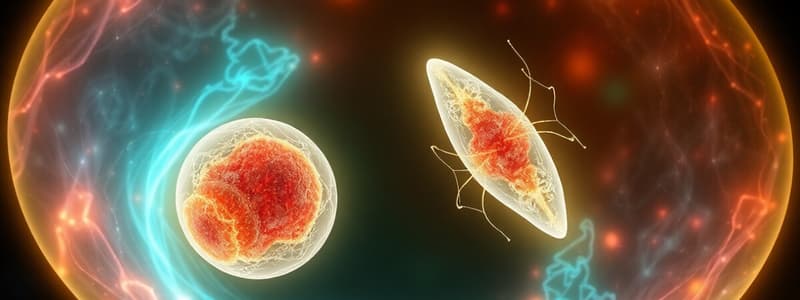Podcast
Questions and Answers
What defines homologous chromosomes?
What defines homologous chromosomes?
- Chromosomes that pair together during meiosis and have the same length and centromere location. (correct)
- Chromosomes that have different lengths and gene types.
- Chromosomes that originate from a single parent.
- Chromosomes that do not undergo crossing over.
Which of the following represents a type of chromosomal mutation?
Which of the following represents a type of chromosomal mutation?
- Trisomy
- Crossing over during meiosis
- Gene duplication on the same chromosome
- Deletion or translocation of chromosome segments (correct)
Which statement is true regarding sex-linked traits?
Which statement is true regarding sex-linked traits?
- Males are hemizygous for genes on the X chromosome. (correct)
- Traits are located exclusively on the Y chromosome.
- Sex-linked traits can only affect females.
- Both males and females can be hemizygous for all traits.
What condition is characterized by the presence of a single X chromosome in a female?
What condition is characterized by the presence of a single X chromosome in a female?
What is the purpose of chi-square analysis in genetics?
What is the purpose of chi-square analysis in genetics?
What is the primary purpose of meiosis?
What is the primary purpose of meiosis?
Which phase of the cell cycle is characterized by DNA duplication?
Which phase of the cell cycle is characterized by DNA duplication?
What distinguishes crossing over during meiosis?
What distinguishes crossing over during meiosis?
Which regulation mechanism requires that cells be attached to a surface to divide?
Which regulation mechanism requires that cells be attached to a surface to divide?
What is the outcome of nondisjunction during meiosis?
What is the outcome of nondisjunction during meiosis?
During which phase of the cell cycle does a cell enter a resting state?
During which phase of the cell cycle does a cell enter a resting state?
What is the role of checkpoints in the cell cycle?
What is the role of checkpoints in the cell cycle?
What is characteristic of cancer cells compared to normal cells regarding division?
What is characteristic of cancer cells compared to normal cells regarding division?
Flashcards
Binary Fission
Binary Fission
Cell division in prokaryotes where DNA replicates, and the cell splits into two identical daughter cells.
Cell Cycle
Cell Cycle
The process where a cell grows, copies its DNA, and divides into two daughter cells.
Interphase (G1 phase)
Interphase (G1 phase)
The stage where the cell grows, produces proteins, and prepares for DNA replication.
S Phase
S Phase
Signup and view all the flashcards
G2 Phase
G2 Phase
Signup and view all the flashcards
Cytokinesis
Cytokinesis
Signup and view all the flashcards
Transformation (Cancer)
Transformation (Cancer)
Signup and view all the flashcards
Meiosis
Meiosis
Signup and view all the flashcards
Linked Genes
Linked Genes
Signup and view all the flashcards
Chi-Square Analysis
Chi-Square Analysis
Signup and view all the flashcards
Chiasmata
Chiasmata
Signup and view all the flashcards
Bar Body
Bar Body
Signup and view all the flashcards
Aneuploidy
Aneuploidy
Signup and view all the flashcards
Study Notes
Cell Division
- Binary fission is DNA duplication followed by cell splitting in two.
- Prokaryotes use this simple reproductive strategy.
- The cell cycle has distinct phases.
- Interphase consists of G1 (growth, checkpoint), S (DNA duplication), and G2 (preparation).
- Mitosis is the nuclear division phase.
- Checkpoints (G1, G2, M) regulate cell cycle progression.
- G0 is the resting phase, where cells stop dividing (e.g., neurons).
- Cytokinesis is the division of the cytoplasm; methods differ in organisms (plants, animals, fungi).
- Density-dependent inhibition stops cells from dividing when crowded.
- Anchorage dependence requires cell attachment for division.
- Cancer cells lack density-dependent inhibition, exhibiting uncontrolled growth.
- Transformation is the process of normal cells becoming cancerous.
Meiosis
- Meiosis is crucial for sexual reproduction, generating gametes.
- Diploid cells (full set) are crucial starting material.
- Haploid cells (half set) form as a result of meiosis.
- Meiosis I separates homologous chromosomes, including crossing over in Prophase I.
- Random alignment of homologous pairs in Metaphase I increases diversity.
- Meiosis II separates sister chromatids to make four haploid cells.
- Gamete formation varies in males (4 sperm per diploid cell) and females (1 egg + polar bodies).
- Crossing over in Prophase I exchanges genetic material between homologous pairs.
- Nondisjunction results in abnormal chromosome numbers (e.g., Down syndrome).
Genetics
- Genes are DNA sequences coding for proteins.
- Locus is the specific location of a gene on a chromosome.
- Sexual reproduction enhances adaptability.
- Asexual reproduction produces clones efficiently but lacks diversity.
- Homologous chromosomes have corresponding lengths, centromere positions, and gene types.
- Autosomes are non-sex chromosomes (22 pairs).
- Sex chromosomes determine sex (XX = female, XY = male).
- X-linked traits are carried on the X chromosome (e.g., colorblindness).
- Hemizygous refers to males having one X chromosome copy for traits on that chromosome.
- Chromosomal mutations (deletions, translocations) are often severe or lethal.
- Syndromes result from specific chromosomal mutations (e.g., Turner, Klinefelter syndromes).
- XXY is Klinefelter syndrome, with male characteristics and some female traits.
Mendelian and Molecular Genetics
- Linked genes are inherited together (due to proximity on the same chromosome).
- Crossing over can separate linked genes.
- Chi-Square Analysis is a statistical method to determine if observed data matches expected data. Formula ( \chi^2 = \sum \frac{(O - E)^2}{E} ).
- Fruit flies (Drosophila) are widely used in genetic studies, due to rapid reproduction, easily observable traits, and simple genetic makeup.
- XX and XY determine fruit fly sex.
Important Terms
- Aneuploidy: Abnormal chromosome number (e.g., Down syndrome - trisomy 21).
- Chiasmata: Crossover points during homologous chromosome pairing.
- Barr body: Inactivated X chromosome in females.
- Tetrad: Group of four chromatids during meiosis.
Studying That Suits You
Use AI to generate personalized quizzes and flashcards to suit your learning preferences.




